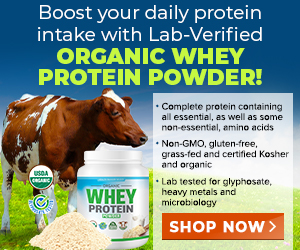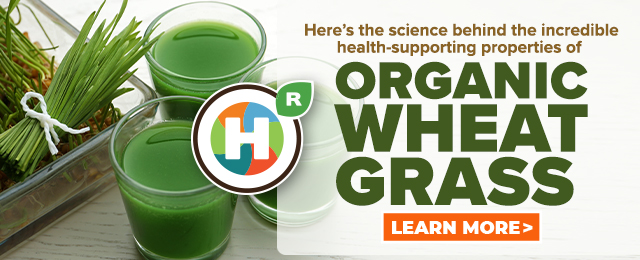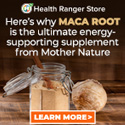
Part I: Understand the Various Forms and Functions of Omega-3 Fatty Acids
Wednesday, May 04, 2011 by: Andrew Kim
Tags: omega-3s, functions, health news
- Decades of ignored warnings: How U.S. regulators failed to act on wireless radiation linked to 23 chronic diseases
- The case for holding Norm Eisen accountable: Deep State’s legal mastermind exposed
- China used as SCAPEGOAT for TikTok ban: ISRAEL was the driving force behind the ban, wanted to quash pro-Palestinian content
- California regulators sound alarm: Herbicide paraquat linked to birth defects, thyroid disease and wildlife risks
- Studies strongly suggest taurine supplementation can promote longevity
- Hollywood Hills ABLAZE: Wildfires devastate Los Angeles, forcing mass evacuations and claiming lives
- DIRTY VACCINES: Dr. Anthony "Fraudulent" Fauci, King of the Covid scamdemic, admits "We don't do placebo trials on vaccines"
- Democrats cry as “liberal supply chains” are wiped out and their favorite multi-billion dollar money machine is shut down
- Beef, milk supply TAINTED with new BlackRock-backed animal drug called Bovaer that claims to stop animal farts
- Trump’s reported FBI finalists mark key battle between deep state and loyalist
- The 20 MILLION DEAD PEOPLE collecting social security payments now are same dead ones who VOTED for BIDEN in 2020 that ILLEGALLY won him the swing states
- B’nai Brith Canada introduces “Seven-Point Plan to Combat Antisemitism” that proposes suspension, firing or PRISON TIME for violators
- EPA’s “insurance policy” against Trump is funneling billions to climate organizations: “We’re throwing gold bars off the Titanic”
- This DNC clip shows why Democrats will keep losing...
- U.S. pension systems are on the verge of debt collapse
- UK under leftism becoming wasteland of political prisoners who violated police state’s anti-speech laws
- DISNEY executive charged with felony child sex abuse … The empire of Disney has always had a child exploitation secret
- The Truth About Cancer attacked by left-leaning group that doesn't want Americans to hear its life-saving message
- Studies strongly suggest taurine supplementation can promote longevity
- Democrats cry as “liberal supply chains” are wiped out and their favorite multi-billion dollar money machine is shut down
- Two containers with completed ballots fall out of truck in Florida
- Stan Johnson on the Health Ranger Report: Henry Gruver’s 2016 vision of second Trump term becomes reality in 2024
- U.S. to sell $300 million upgrade program for South Korean navy’s destroyers
- RFK Jr. clears key hurdle: Sen. Susan Collins backs controversial HHS nominee, signaling a new era for health policy
- UK’s Online Safety Act comes into effect: The dangerous, slippery slope of censorship laws
- EPA advisor admits the agency is funneling billions to climate groups ahead of Trump’s return to White House
- Ukraine’s brutal assassination of Russian General Kirillov reveals the depths of coverup for biological weapons and bio labs in Ukraine
- PBS shutters DEI office in wake of Trump’s executive order
- This DNC clip shows why Democrats will keep losing...
- “Cancer Gag Act” threatens farmers’ rights and public health: A dangerous push for corporate immunity
- Top 10 foods that BOOST DOPAMINE and help you stay focused, fit, positive and motivated
- Mike Adams and Dane Wigington expose the truth: Are homes being intentionally ignited in California?
- Mach 7 drone illustrates China's latest leap in hypersonic technology
- DISNEY executive charged with felony child sex abuse … The empire of Disney has always had a child exploitation secret
- Britain denies reports that Russia’s “most dangerous” warship held military drills in the English Channel
- Trump’s reported FBI finalists mark key battle between deep state and loyalist
- EPA advisor admits the agency is funneling billions to climate groups ahead of Trump’s return to White House
- Global leaders unite to clamp down on “misinformation” with UN-backed Cascais Declaration
- HYSSOP: What research reveals about the health benefits of this ancient holy herb
- I Want My Bailout Money – new song released by Mike Adams
- Global tensions, natural disasters and the looming shadow of world war - all predicted by Mike Adams and Steve Quayle three years ago
- The new American dream: $500,000 nuclear bunkers and the fear of WWIII
- Trump is taking on the media, exposing defamation and WINNING BIG
- Big Banks shift the burden of losses to taxpayers through the Federal Reserve in the form of BAILOUTS
- Is America's "giant debt factory" Federal Reserve setting us up for an economic nightmare?
- Top 10 foods that BOOST DOPAMINE and help you stay focused, fit, positive and motivated
- State Farm cancels thousands of home insurance policies in the Pacific Palisades region months before deadly fires
- Biden announces additional $500M military aid for Ukraine as California wildfires displace 70,000 residents
- Chemotherapy found to increase the number of tumor cells circulating in the blood, spreading it to previously unaffected areas
- Experts warn: Centralized digital currencies could be used to control how people behave
- Russia signals willingness to negotiate peace deal with Ukraine at neutral site in SLOVAKIA, but Ukraine rejects it
- Stan Johnson on the Health Ranger Report: Henry Gruver’s 2016 vision of second Trump term becomes reality in 2024
- Mike Adams Sermon 42: God’s superfruit FIGS can fight warts, staph infections and cancer
- New BRICS banking system will render Western sanctions on Russia USELESS
- Red Cross issues warning to stop blood plasma donations from vaccinated people
- Scientists confirm: GENIUS brain function can be spontaneously unleashed in humans without any apparent cause
- DATA: England’s vaccinated population had close to one million deaths in 23 months; unvaccinated population had less than 61,000 deaths over the same period
- HYSSOP: What research reveals about the health benefits of this ancient holy herb
- Arizona residents drive entire Maricopa County Board of Supervisors out of meeting after serving them for TREASON
- Fully vaccinated about to see “tsunami” of illness and death, warns virologist
- Today I asked our AI language model “Neo” about which phytonutrients or phytochemicals can block the spike protein related to SARS-CoV-2 … Here is what it answered…
- Two containers with completed ballots fall out of truck in Florida
- BREAKING: 2025 NDAA authorizes mandatory military draft of WOMEN across America… as Pentagon pursues global NUCLEAR war with both Russia and China at the same time
- We are building the infrastructure of human freedom… Brighteon.AI is the next launch that will put life-altering LLM technology into your hands for free
- Michael Yon warns of a ZIONIST TAKEOVER in Trump’s second administration
- ENGINEERED FAMINE: Oregon starts SHUTTING DOWN small farms “to protect the people”
- NASA admits that climate change occurs because of changes in Earth’s solar orbit, and NOT because of SUVs and fossil fuels
- Ozempic and Wegovy weight loss drugs are injectable LIZARD VENOM PEPTIDES that may unleash a devastating wave of organ failure… side effects align with symptoms of SNAKE BITES
- These 13 countries just signed an agreement to engineer a global FAMINE by destroying food supply
- Careless Whisper: AI-powered transcription tool being used by hospitals found to invent chunks of text no one ever said
- BBC staffers accuse media outlet’s executives of instituting bias in Gaza coverage, claiming favorable treatment of Israel
- Casual restaurant chain TGI Fridays files for BANKRUPTCY
ALA has three fates. It can be metabolized for energy (beta-oxidation), used as a carbon source for the production of other molecules (carbon cycling), or converted to long chain derivatives.
ALA and its derivatives - eicosapentaenoic acid (EPA), docosahexaenoic acid (DHA), and docosapentaenoic acid (DPA) - incorporate into the cell membranes, influencing eicosanoid synthesis, cell signaling cascades, and gene expression.
It has been argued that humans cannot adequately convert ALA to DHA. However, studies indicate that omega-3 fatty acids accumulate in a tissue-dependent manner and convert to derivatives in a tissue-selective manner. This new understanding implies that different tissues accrete and metabolize omega-3 fatty acids differently based on need. For example, the brain rapidly utilizes and converts plasma ALA to DHA, whereas the heart does not.
Human and animal dietary studies show that ALA alone may be able to provide adequate amounts of EPA and DHA. Past studies report low conversion rates from ALA to EPA and extremely low rates from ALA to DHA. Insights provided by the new paradigm described above suggest that these numbers reflect the rates of the body as a whole instead of at the level of individual tissues.
When adequate doses of ALA are consumed, DHA-requiring tissues and the liver are able to amply supply DHA. The liver is the primary organ responsible for the conversion from ALA to its various derivatives. When ALA in the diet is low, the liver compensates by up-regulating the rate of conversion to meet the body's need for EPA and DHA. Therefore, the plasticity of the liver and the slow turnover rate of DHA (i.e. in the brain) may allow ALA to adequately meet the body's omega-3 demands, even when dietary intake is low on some days (see note).
Contrary to popular belief, all ALA is not converted to derivatives. The body uses up to twenty times more ALA than its derivatives (95% stay as ALA, leaving only 5% to be broken down into derivatives). Therefore, ALA is anything but a passive molecule.
New research continues to uncover the virtues of ALA. Some of the many benefits of ALA include:
-Cardiovascular protection
-Proper neural development
-Anti-inflammatory (independent of EPA)
-Neuro-protection
-Improved cholesterol profile
-Lower blood pressure
-Improved lung function in asthma patients
-Greater improvement of inflammatory bowel disease (IBD), ADHD, and autoimmune diseases (as compared to fish oil).
-Maintenance of long chain omega-3 fatty acids in the tissues.
-Treats dry eye syndrome (when applied topically)
-Anti-depressant effect
Vegans may benefit from ALA supplementation to provide and maintain adequate levels of longer chain derivatives of omega-3, which are predominantly found in animal foods. For the rest, consume enough ALA and LA* - about a teaspoon total a day in the correct ratio** - along with some derivatives found in whole foods, and let your body sort out the rest.
* linoleic acid
**see "Clear up the Misconceptions about Omega-6 Fatty Acids"
Note: Deficiencies of biotin, Vitamin E, protein, zinc, magnesium, B12, and B6 interfere with the activity of desaturases and elongases. Refined sugars, starches, trans-fatty acids, and insulin disrupt EFA metabolism as well. Saturated fats, which are resistant to oxidation, protect and enhance utilization of EFAs.
Part II will review the other members of the omega-3 family
Sources
1.Pharmacology (Rang and Dale)
2.Nutrition: A Health Promotion Approach (Webb)
3."Update on alpha-linolenic acid" (Nutrition Reviews; 2008)
4."Alpha-linolenic acid and its conversion to longer chain n-3 fatty acids: Benefits for human health and a role in maintaining tissue n-3 fatty acid levels"(Progress in Lipid Research; 2009)
5."Drops of fatty acid curb symptoms of dry eye syndrome in animal model: Topical alpha-linolenic acid shows promise as alternative application, bypasses many side effects" (Dana; 2008)
6."Subchronic Alpha-Linolenic Acid Treatment Enhances Brain Plasticity and Exerts an Antidepressant Effect: A Versatile Potential Therapy for Stroke"(Neuropsychopharmachology; 2009)
7.Primal Body-Primal Mind (Gedgaudas)
8. "The Fats of Life" (Pond)
About the author
Andrew KimAndrewkim21@gmail.com
Omega-3s at FETCH.news
Get independent news alerts on natural cures, food lab tests, cannabis medicine, science, robotics, drones, privacy and more.
Take Action: Support Natural News by linking to this article from your website
Permalink to this article:
Embed article link: (copy HTML code below):
Reprinting this article:
Non-commercial use OK, cite NaturalNews.com with clickable link.
Follow Natural News on Facebook, Twitter, Google Plus, and Pinterest
Science News & Studies
Medicine News and Information
Food News & Studies
Health News & Studies
Herbs News & Information
Pollution News & Studies
Cancer News & Studies
Climate News & Studies
Survival News & Information
Gear News & Information
News covering technology, stocks, hackers, and more



"Big Tech and mainstream media are constantly trying to silence the independent voices that dare to bring you the truth about toxic food ingredients, dangerous medications and the failed, fraudulent science of the profit-driven medical establishment.
Email is one of the best ways to make sure you stay informed, without the censorship of the tech giants (Google, Apple, Facebook, Twitter, YouTube, etc.). Stay informed and you'll even likely learn information that may help save your own life."
–The Health Ranger, Mike Adams












































